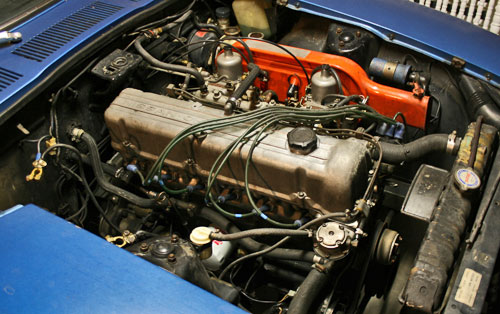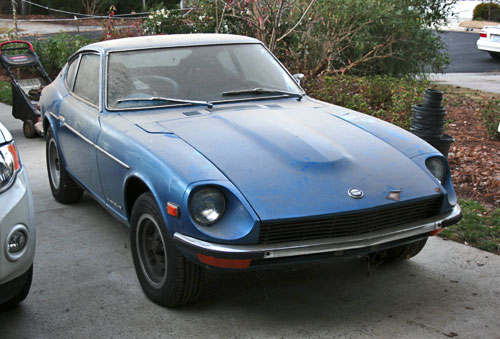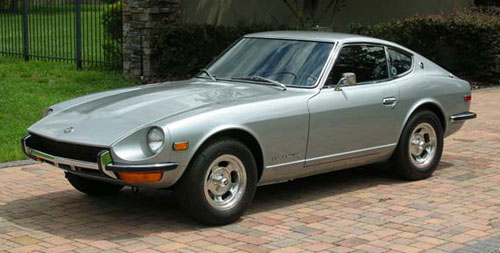Datsun 240Z Restoration: Little Things

A few notes from the last month or so of having the Z home:
- I bought How to Rebuild Your Nissan/Datsun OHC Engine last week as a sort of early birthday present for myself. Its purchase completes my acquisition of the “trilogy” of glossy Datsun Z-Car books. The other two books are How to Modify Your Nissan/Datsun OHC Engine (lots of naturally-aspirated race-prep stuff; very little on turbocharging) and How to Restore Your Datsun Z-Car (an absolute gold mine for the would-be restorer, with step-by-step instruction on teardown and reassembly, parts diagrams and loads of photographs). Gotta get a set of the factory shop manuals next.
- The battery is removed from the car, but last night, in a kind of experiment, I hooked up my battery charger to the leads, turned the knob to “low charge” (5A or so) and turned the car on. Everything was as weak, as you’d expect from say, a dying battery, but it did something for me to be able to turn on the hazards, illuminate the lights and fiddle with the (original!) radio. Sometimes you just need to see a sign of life, you know? First time that’d been done in 8 years.

- I’ve been trying to determine whether or not the Z’s engine is original. Its status that way will have a big impact on how I go about restoring and/or upgrading the car. If it’s original, then I’d like to keep it original, which makes upgrading a bit more difficult (overboring the block from 2.4 to 2.8 liters isn’t quite as easy as I had thought it might be). If it’s a replacement engine, then all bets are off and, rather than rebuild it, I can swap it out for an engine that was 2.8l from the factory, the L28. So, how to establish the engine’s credentials? There’s an ID plaque (shown at top) affixed to the passenger side strut tower in the engine bay with the VIN and engine block number stamped on it. I hadn’t noticed it until now because when the Z was repainted in the late ’70s, the engine bay was blacked out and the ID plaque painted over. So, last night, I located the engine number on the block, shown above: 118555. I then removed the voltage regulator, allowing me to access and remove the ID plaque. I scraped as much paint off it as I was willing to last night (will eventually do the whole thing), but enough for me to read the block number listed: 110555. I’m almost positive it’s just a typo, but plan to ask those more familiar with these things for their take on the matter.
Editor’s note: This post is Part 6 of an ongoing series chronicling my efforts toward the restoration of my 1972 Datsun 240Z, originally my father’s. Read the other installments here:
- Part 23: Gutting the Interior
- Part 22: The Teardown Begins
- Part 21: …And the Engine Comes Out
- Part 20: Treasure Hunting
- Part 19: Beginnings
- Part 18: VIN Discoveries
- Part 17: The Bad News
- Part 16: On The Road
- Part 15: Getting It Back On The Road
- Part 14: It Lives!
- Part 13: Restoring the Fuel System, Part I
- Part 12: Meat on the Wheels
- Part 11: Inspiration (Sort Of)
- Part 10: Carbs’ Return
- Part 9: First Triad Z Club Meet
- Part 8: Wheel Work
- Part 7: Tactical Changes
- Part 5: Coming Home
- Part 4: The Rollout
- Part 3: Confessions of a Poor Car Enthusiast
- Part 2: Opening the Tomb
- Part 1: Projecting Forward
Update (01/16 9:01 PM): Received some information about the VIN/ID plate numbers mismatch from a knowledgeable gentleman on one of the Z forums:
Looks to me like you have a mis-stamped service block.
The numbers don’t have the familiar “cursive” bent normally associated with Nissan OEM Stamps.See the “L24?” The scripted numbers for the engine block should be similar, with the top section of the “8” looking somewhat like an onion with the green chopped off, if that makes any sense, along with the bottom section of the “5” being a bit more “open” and not a “reverse C” configuration.
I have never seen a mismatched plate/engine from Nissan, ever.
My surmise would be that you have a “service block” which arrived with no serial number in it, and generally the dealers left that blank when they installed it.
Looks like someone sometime got a letter-number stamp and just put the numbers on your block.
And they mucked it up.
Having a service Block in with no serial number arguably can be said to have a “Factory Service-Replacement Nissan Engine” and wouldn’t necessarily be knocked down for not having an “original” engine. (Some Z owners blew their ’70s engines at autox and got replacement engines from Nissan under warranty! What happened to those days GT-R tranny owners?)
Unfortunately, what you have is most definitely not “matching numbers,” but if you had service history to show the swap/change you could argue the accident like you theorize.
I’m querying my dad (the Z’s original owner) to hopefully get more of the story, if there is more to it. I just wanna know, you know?














